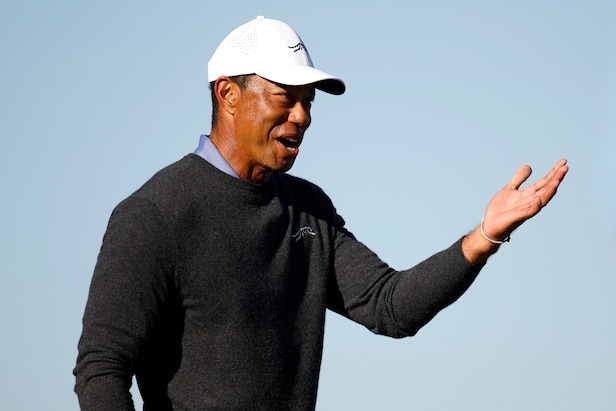2024 PGA Championship Preview: Is 20 Plenty? – Australian Golf Digest

- by Admin
- April 23, 2024

Are 20 club pros in the PGA Championship field too many? Australians have benefitted from the much-maligned exemption category through the years, but does it really dilute golf’s only all-pro major?
Five years before Michael Block made a hole-in-one in the final round of the 2023 PGA Championship playing alongside Rory McIlroy, taking the golf world by storm with his feelgood story, the club pro was fighting to make the cut at the 2018 PGA Professionals Championship in northern California. The event is the national tournament for club pros in America, where the top 20 finishers gain entry to play in a major alongside tour pros at the PGA Championship.
In the second round at The Bayonet course that year, Block appeared to lose his ball with his tee shot on the par-4 15th hole. His son, Dylan, who was 13 at the time, was caddieing for his old man and saw a hole in the bottom of a tree where the ball landed. Dylan reached into the hole and pulled out dad’s golf ball. Block was given relief from the “burrowing animal hole” and went on to make birdie and the 36-hole cut. He eventually finished tied for 16th, thus qualifying for the 2018 PGA Championship at Bellerive Country Club, minutes from where he grew up in St Louis, Missouri. Although he missed the cut at Bellerive, where Brooks Koepka defeated Tiger Woods for victory, Block had a cracking story.

Fast-forward to 2023 and Block, winner of the 2014 PGA Professionals Championship, pulled off the unthinkable when he finished equal 15th at the PGA Championship at Oak Hill. He finished ahead of tour stars like Min Woo Lee, Tyrrell Hatton and Xander Schauffele. Memorably, he created a viral moment when he made a slam-dunk ace at the par-3 15th while a stunned McIlroy shook his head and laughed. Block’s T-15, earned via a clutch par save on the 72nd hole, was the best PGA Championship finish by a PGA professional since Lonnie Nielsen’s T-11 at Inverness in 1986.
Block, a teaching pro at Arroyo Trabuco, a course located between Los Angeles and San Diego, was a cultural phenomenon. But his success at the 2023 PGA Championship highlighted a debate within golf and the PGA Championship specifically: should one of the game’s four majors award 20 spots in a field of 156 to club professionals?

Those who’d answer no point to Block’s success as an exception, and not the rule. They argue that Block was a shooting star, while typically no more than one club pro makes the cut at the PGA Championship each year (and many years there are none on the weekend). But those who see Block as a reason to keep the number at 20 make a valid argument that, if the PGA of America bowed to pressure and slashed that number – which it has in the past – it could rule out future stories like Block and other interesting club pros. After all, Block finished T-16 in the 2018 PGA Professionals Championship. What if that was the year he pulled off a top-20 in the PGA Championship by virtue of knowing Bellerive so well?
A case against the 20 comes from a handful of tour players who, after failing to secure eligibility for the PGA Championship, are forced to sit at home as club pros that perennially underperform in a major tee it up. Conversely, club pros validly argue the PGA is the only major not to invite amateurs and that they have more of a reason to be in a major. While neither category is likely to win a major, at least amateurs are being exposed to a level they need to work towards to make a career out of golf. They are shown the benchmark. The major that welcomes the most amateurs, the Masters, has no limit on its field size. Augusta National’s invitations don’t come at the expense of tour pros.
Perhaps a more important question is this: is there a magic number if it’s not 20? Until 1994, the PGA Championship invited 40 club professionals. That number was cut to 25 and again, in 2006, to 20.

Brett Jones, the brother of two-time Australian Open champion Matt Jones, can’t decide on how many should be culled from 20. But he does think it should be reduced. Brett created a feelgood story of his own in 2015 when, working as a club pro at the ultra-exclusive Due Process Stable golf club in southern New Jersey, he finished tied for fifth at the PGA Professionals Championship at the revered Philadelphia Cricket Club.
“With three holes to go, I was right on the number to make it inside the 20 safely,” he recalls. “I got a wicked mud ball on the 17th for my second [shot]. I hit it into the left greenside bunker and then holed the shot [for birdie]. On No.18, I was pumped up and pounded a drive way down the fairway, then hit a horrendous pitch shot but holed a 40-footer for birdie to finish two shots inside the number that avoided
a playoff.”
Brett joined Matt in the 2015 PGA at Whistling Straits in Wisconsin, where they became the first Australian brothers to tee up in a PGA Championship. Matt led after 36 holes at Whistling Straits while Jason Day eventually won.
Despite that whirlwind week, where Brett missed the cut, he thinks 20 is too many.
“It’s a Catch-22 for me because it was a great experience for me as a PGA of America member and I’m cognizant of how great the organisation is to provide that opportunity for their members. But looking at the results, I can understand the other point of view,” Jones tells Australian Golf Digest. “Having Matt as a brother, I can understand where tour pros come from when they say the PGA Championship doesn’t provide as strong a field as it could. You have 20 club pros playing each year, and I was one of them. Only one player ever makes the cut and that’s not every year. I just don’t know if reducing the number – whether that’s to 10 as the right number – I just know there are too many.”
Fellow Aussie Craig Hocknull is somewhat like Block in that he is an example of why 20 club pros is the right number. He has a captivating story, and he could play. He had a Korn Ferry Tour card at one stage but battled wrist injuries. Hocknull says it would be devastating for club pros if the number was slashed.
“Think of the stories you would miss out on,” he says.

Hocknull’s story is a belter. In the early 1990s, he left Australia to play college golf at Jackson State University, a historically black school. He played in tournaments against Tiger Woods, who is the same age. At Jackson State in 1994, Hocknull and four roommates were relaxing in their apartment when two gun-wielding assailants attempted to break through the front door. Hocknull reacted quickly and slammed the door on one of the attacker’s arms before a nightmarish 911 phone call and a long wait for the authorities. “It was frightening,” he recalls. “Growing up in Australia, I don’t think I ever saw a gun.”
Hocknull, now the teaching pro at the prestigious Westchester Country Club in New York, was once a travelling trick-shot artist who produced the Outback Golf Show in 2003 – where he dressed like “Crocodile Dundee” and performed his skills around the world – before transitioning to a career as an accomplished instructor and clubmaker in the US.
He qualified for the 2018 PGA Championship at Bellerive, and again the next year at Bethpage in New York. Both starts came via the PGA Professionals Championship. Hocknull was indeed a compelling story at both majors.
“It shouldn’t be cut from 20,” he insists. “History would say there were 156 club pros in the very early beginnings of the PGA Championship [before being a tour pro was a sustainable occupation]. It was whittled down to 40 only 30 years ago, then 25 and now 20. The 20 who make it through are no slouches; you’ve got players like Mike Small, a former PGA Tour player who is now the coach at the University of Illinois, or Ben Kern, who is the pro at Hickory Hills Golf Club in Ohio. He made the cut and finished T-42 in 2018 at Bellerive. When a tour pro misses the cut, they don’t mind because they have more than 20 tournaments a year to play and keep sharp. But when a club pro plays in a major, it may be their one PGA Tour event that year. They haven’t had much time to prepare; they’ve been doing lessons, serving their members. Literally the day or two before they leave for the PGA Championship, most club pros are working in the pro shop at their club. It’s all about the preparation.”
A counterpoint to Hocknull’s philosophy, though, is that there are other opportunities for club pros to compete at the PGA Tour level and have their story told. Historically, the Byron Nelson tournament on the PGA Tour grants a sponsor’s exemption to the North Texas PGA of America section champion. Same goes at the WM Phoenix Open, which grants the Southwest PGA section champion a spot at TPC Scottsdale.
“I don’t think [cutting to less than 20 would mean missing out on great stories],” Jones says. “[Club pros] have had enough opportunities to perform at that elite level.”
A fascinating example is an American club pro named Mark McCormick, the father of PGA Tour pro Ryan McCormick. McCormick Snr is the teaching pro at Suburban Golf Club, an A.W. Tillinghast-designed course 30 minutes from New York City. He has never made it through the PGA Professionals Championship but did advance through US Open sectional qualifying in his home state in 2012. He was 49 years old and gave final qualifying one last try at Canoe Brook in New Jersey. The left-hander then got to play with his idol, fellow lefty Phil Mickelson, in a practice round at the
US Open a week later at Olympic Club in San Francisco.

“It’s kind of mind-boggling,’’ McCormick told New York Post’s Mark Cannizzaro at the time. “I’m playing with Phil. My kids are walking the fairways with us. I’m playing in a US Open practice round. It’s beautiful out. I’m in sunny California and I’m playing Olympic.”
McCormick earned it through an avenue truly available to anyone, although that’s not to say the 20 club pros have not earned it.
For now, at least, there is more of an argument to keep the number at 20. Out of 156 in the field at the PGA, 136 tour pros is more than enough to cover every top player. Are golf fans really interested about any pro who isn’t good enough to be in that 136? Probably not. As professional golfers become more robotic, sticking to their “processes” and “teams” and rattling off clichés about taking it one shot at a time, it’s reasonable to say the unique stories of the 20 club pros offer more value to fans than mid-level tour pros.
The Latest News
-
December 22, 2024Tiger Woods’ son Charlie makes a hole-in-one in the final round of the PNC Championship – Australian Golf Digest
-
December 22, 2024Tennis’ love match: Meet ‘Aussie’ Matteo Arnaldi and his Melburnian girlfriend
-
December 22, 2024GEORGIE PARKER: McSweeney was McStiff to get axed
-
December 22, 2024Chris Eubanks picks the ATP player he considers a real dark horse to win the Australian Open
-
December 22, 2024Time for the Swedish chef: Ikea’s furniture profits are down in Australia, but food sales are booming





